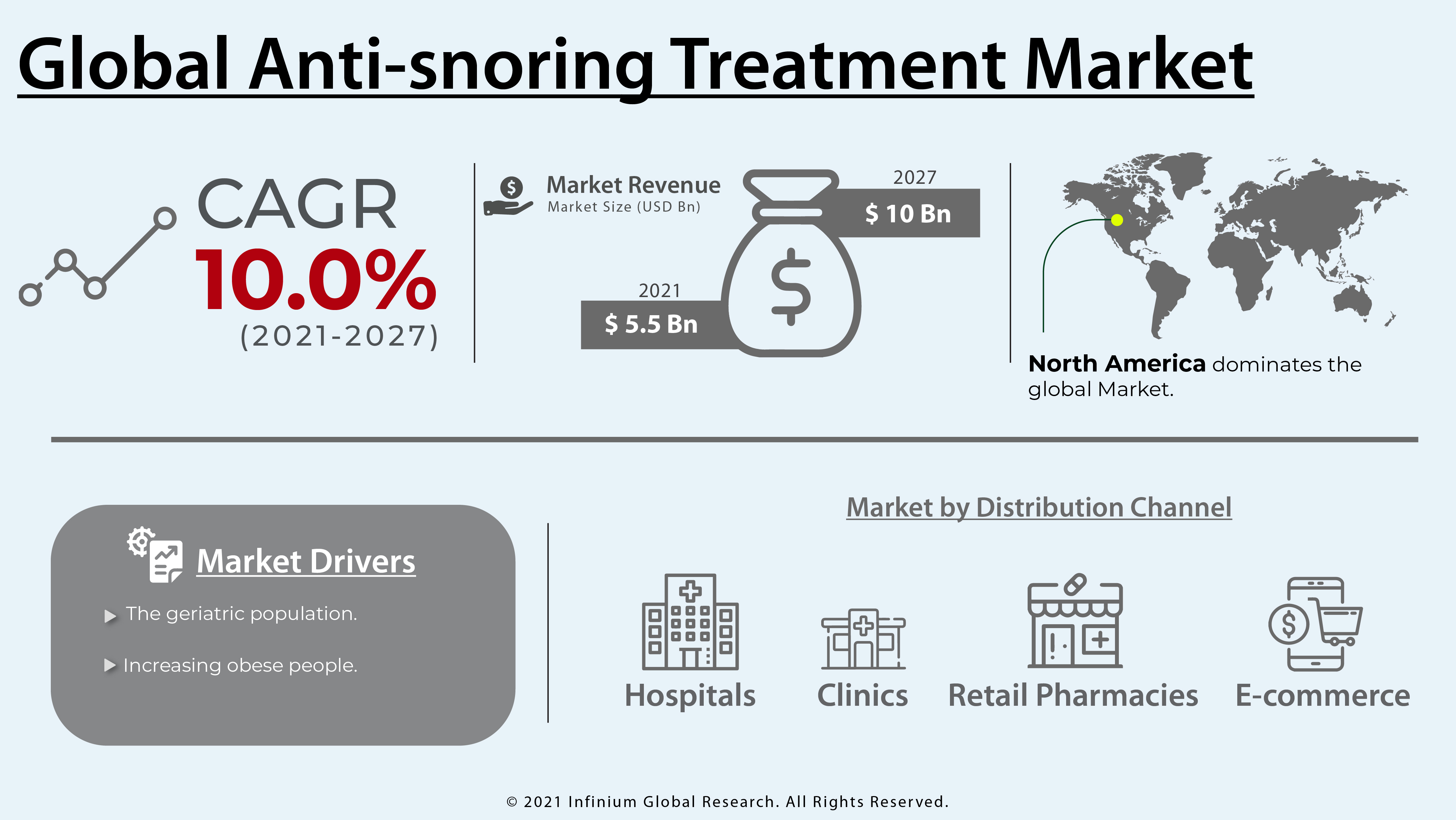Anti-snoring Treatment Market (Devices - Mandible Advancement Devices, Tongue Stabilizing Devices, Nasal Devices, Continuous Positive Airway Pressure Devices, and Chin Straps; Distribution Channel - Hospitals, Clinics, Retail Pharmacies, and E-commerce; Surgery Type - Uvulopalatopharyngoplasty (UPPP), Laser-assisted Uvulopalatoplasty (LAUP), Radiofrequency Ablation (somnoplasty), Pillar Procedure, Injection Snoreplasty/ Sclerotherapy, Palatal Stiffening Procedures, and Others): Global Industry Analysis, Trends, Size, Share and Forecasts to 2027
A recent report published by Infinium Global Research on the anti-snoring treatment market provides an in-depth analysis of segments and sub-segments in the global as well as regional anti-snoring treatment market. The study also highlights the impact of drivers, restraints, and macro indicators on the global and regional anti-snoring treatment market over the short term as well as long term. The report is a comprehensive presentation of trends, forecast and dollar values of the global anti-snoring treatment market. According to the report, the global anti-snoring treatment market was approximately worth USD 5.5 billion in 2021 and is expected to reach up to USD 10 billion by 2027, growing with a CAGR of 10% over the forecast period of 2021-2027.

Market Insight
An anti-snoring mouthpiece is a viable treatment for snoring. Many people snore because airflow, as breathes, causes the tissues in the back of the throat to vibrate. Anti-snoring aids such as mouthpieces help bring the jaw forward to widen the back of the airway, allowing air to pass through without resistance, stopping snoring. There are two main types of anti-snoring mouthpieces Tongue Stabilizing Devices (TSD) and Mandibular Advancing Devices (MAD). Medical researchers continue to discover new treatment methods for snoring like more recent innovation is hypoglossal nerve stimulation. For this procedure, surgeons essentially reprogram the nerves that control the tongue’s movements in order to prevent airway blockage.
However, the FDA has been working to adapt its policies and restrictions to respond to the growing need for unconventional solutions like shortages of medical equipment needed for treating COVID-19 patients. A group of doctors, engineers, and medical researchers from UC Berkeley, UCSF, and working hospitals have devised a creative solution to the ventilator shortage. They’re working with readily available hardware and a stockpile of medical breathing equipment that’s resting mostly unused under noses. The group has figured out a way to modify existing CPAP machines typically used to treat sleep apnea to act as the kinds of ventilators needed for intubation to keep severe COVID-19 patients breathing in the ICU. Increasing obese people, is commonly attributing to the growth of the anti-snoring treatment market. Obesity is a common cause of sleep apnea in adults. People with obesity have increased fat deposits in their necks that block the upper airway. As one reaches middle age and beyond, the throat becomes narrower, and the muscle tone in the throat decreases. Furthermore, the geriatric population is driving the growth of the market. As per the World Ageing Population report, in 2019, about 702.9 million people living were aged 65 years and above and this number is expected to reach 1,548.9 million by the year 2050. In addition, alcohol intake, smoking, and certain medications, such as tranquilizers like diazepam (Valium) and lorazepam (Ativan), can increase muscle relaxation and lead to more snoring. However, lack of scientific validation on the effectiveness of anti-snoring devices, poor efficacy of current anti-snoring treatments available in the market, and high cost of some of the snoring surgery procedures are affecting the growth of the ant snoring treatment market. Moreover, technological advancements in anti-snoring devices and increased awareness among the people are the key factors responsible for the growth of the market.
North America dominates the anti-snoring treatment market. An increasing incidence of obese people and the adoption of unhealthy lifestyles are contributions to the growth of the market in this region. Furthermore, rising awareness about the availability of anti-snoring devices and their easy accessibility is driving the market growth in North America. According to the National Sleep Foundation (NSA), around 90 million adults suffer from snoring problems in the United States. Moreover, new technologies that are constantly being developed in the country, and growing initiatives to spread awareness regarding sleep disorders will stimulate the growth of the North America anti-snoring treatment market.
Segment Covered
The report on the global anti-snoring treatment market covers segments such as devices, distribution channel, and surgery type. On the basis of devices, the sub-markets include mandible advancement devices, tongue stabilizing devices, nasal devices, continuous positive airway pressure devices, and chin straps. On the basis of distribution channel, the sub-markets include hospitals, clinics, retail pharmacies, and e-commerce. On the basis of surgery type, the sub-markets include uvulopalatopharyngoplasty (UPPP), laser-assisted uvulopalatoplasty (LAUP), radiofrequency ablation (somnoplasty), pillar procedure, injection snoreplasty/sclerotherapy, palatal stiffening procedures, and others.
Companies Profiled:
The report provides profiles of the companies in the market such as Apnea Science, SomnoMed, Koninklijke Philips, Airway Management Inc, Tomed GmBH, Meditas, GlaxoSmithKline Plc, Fisher & Paykel Healthcare, ResMed, and The Pure Sleep Co.
Report Highlights:
The report provides deep insights into the demand forecasts, market trends, and micro and macro indicators. In addition, this report provides insights into the factors that are driving and restraining the growth in this market. Moreover, The IGR-Growth Matrix analysis given in the report brings an insight into the investment areas that existing or new market players can consider. The report provides insights into the market using analytical tools such as Porter's five forces analysis and DRO analysis of the anti-snoring treatment market. Moreover, the study highlights current market trends and provides forecast from 2021-2027. We also have highlighted future trends in the market that will affect the demand during the forecast period. Moreover, the competitive analysis given in each regional market brings an insight into the market share of the leading players.
